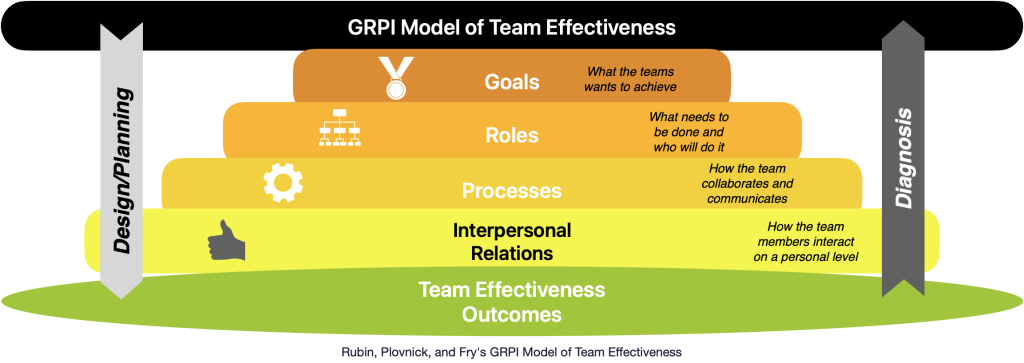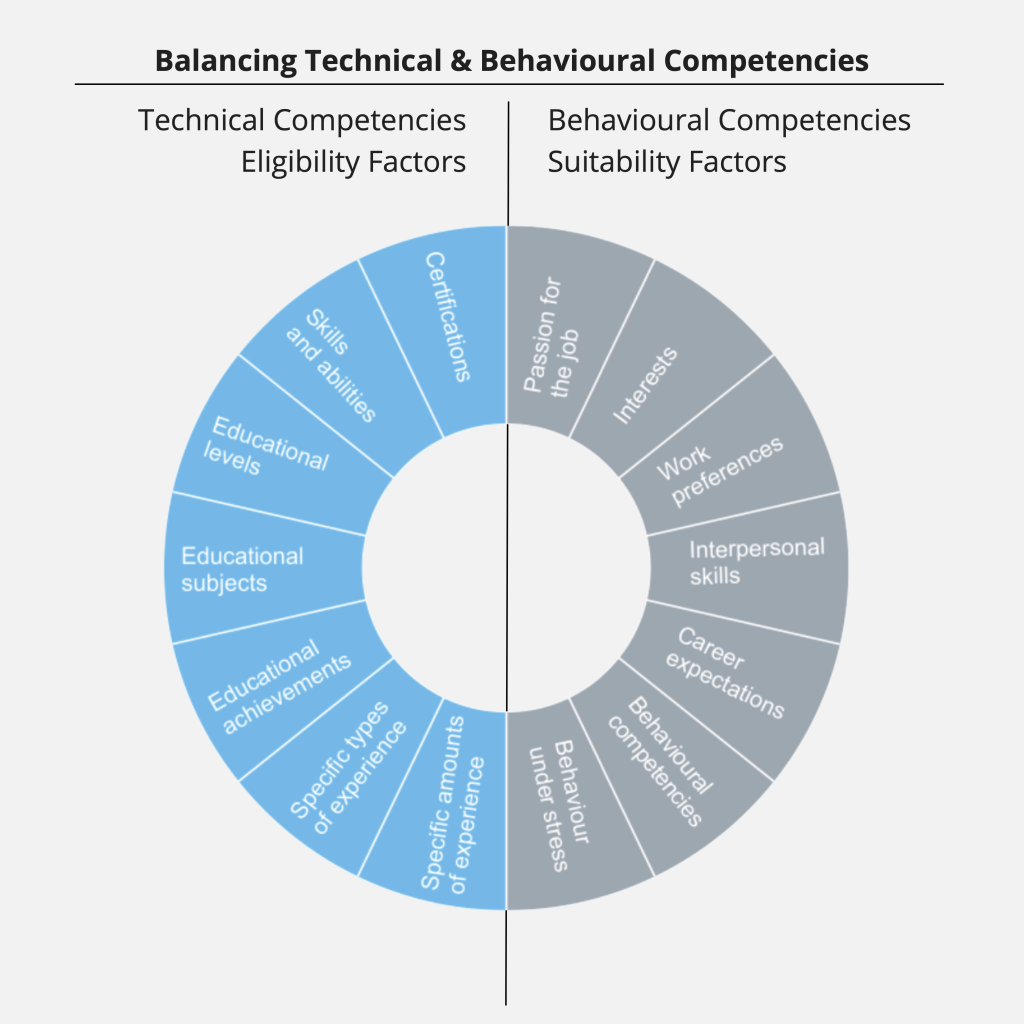Why building high performing teams is hard
Imagine a high-performing team. Tasks flow seamlessly, ideas spark and build on each other, and deadlines are met not just on time, but with a sense of accomplishment. This efficiency isn’t magic; it’s the result of strong team dynamics. However, many teams struggle with dysfunctions that create friction and hinder progress.
Patrick Lencioni’s seminal work, “The Five Dysfunctions of a Team,” identifies five core issues that plague teams: Absence of Trust, Fear of Conflict, Lack of Commitment, Avoidance of Accountability, and Inattention to Results. These dysfunctions, if left unchecked, can lead to a domino effect, crippling communication, hindering leadership, and ultimately stalling the team’s effectiveness.

Rubin, Plovnick, and Fry tell us in their GRPI Model of Team Effectiveness that—among others—the design and planning of the desired outcomes, the diagnosis of issues and the interpersonal relationships are major contributors to how effective teams become. These are all aspects managers can control!

In this article, we’ll take a look at some of the tools at your disposal to transform your team from a collection of individuals into a well-oiled machine, where strong dynamics become the engine for peak performance.
Taking a concept from paper to a successful implementation requires a symphony of minds. Each team member brings their own ideas, perspectives, and even biases, all of which can significantly impact efficiency.
We all have ingrained behaviours, developed over time, that often lead to predictable outcomes. However, some behaviours create unintended consequences—blind spots—where the input and output are unclear.
Imagine how you might react when stressed and pressured to make a quick decision. You might default to a “fight or flight” response, becoming defensive or even submissive. These unintentional consequences, though not malicious, can lead to hurt feelings, a lack of trust, and ultimately, hindered performance.

How to improve team performance — quickly and efficiently
Given time and a calmer environment, our responses can become more calculated. We might exhibit clarity, confidence, or logical reasoning—all leading to the desired outcome.
These seemingly contradictory behaviours highlight the essence of an effective team. Organisations that can adapt to change, not just globally but also in daily interactions, have a distinct advantage.
The key lies in managing these paradoxical behaviours, both from a leadership and individual standpoint. Our goal is to create the most efficient and enjoyable process for bringing ideas to market swiftly and predictably.
Dr. Dan Harrison, creator of the Harrison Assessment, defines paradoxical behaviours as "two behaviours that appear to be oppositional or contradictory, yet interdependent and synergistic, making up a whole."
To help teams assess where they are compared to where they need to be, we have developed a unique process of mapping the specific leadership and follower behaviours needed to predictably deliver an organisation’s strategic intent throughout every critical stage of initiating, motivating, implementing, and maintaining.
How does it work?
- Take a short survey: Everyone on the team fills out a quick 20-minute online survey.
- Team report: Based on the survey and leader’s input, a qualified facilitator creates a report on the team’s strengths and weaknesses. This report shows what the team needs to focus on (effective and ineffective team behaviours) to achieve its goals.
- One-on-one debrief: To help them understand their survey results, each team member schedules their individual 90-minute debrief with our People and Performance Specialist.
- Improve teamwork: The team leader uses this report to understand how best to master the team’s ‘dynamic’ for greater performance. The report also becomes the objective foundation for an interactive Team Dynamic workshop.
Who is it for?
Improving outcomes through improved team dynamics makes sense for teams ranging from frontline operators to the CEO and their C-Suite, and everything in between.
When or how often should we do this process?
This process provides unique insight into the working dynamics of any team and is particularly beneficial when new teams are formed, when performance is not as expected and as a periodic ‘fine tune ‘ of team or individual performance and development.
Where is the best place to do it?
The assessment is online. The most convenient way for all subsequent one-on-one debriefs and workshops is virtual, but face-to-face debriefs may also be conducted at the clients location of choice.
Why improving Team Dynamics quickly and efficiently is a no-brainer
This unique objective behavioural insight empowers your leaders and teams to plan targeted development for each individual or team, provides an objective base line to measure all future development initiatives, maximising individual and team performance against specific goals and desired outcomes. This saves significant time, resources, and frustration, compared to a one-size-fits-all approach.
Furthermore, this approach allows for accurate prediction of how an individual might perform in a new role or how a potential new recruit would integrate into a team. Additionally, it equips leaders with the knowledge to effectively engage and lead diverse teams, harnessing the advantages of a variety of perspectives.
Building a strong team isn’t just about warm and fuzzies or team-building exercises. It’s a strategic investment with a clear ROI. Here are some of the benefits you can expect:
- Sharpened Focus: Clear roles, open communication, and a shared vision ensure everyone is working towards the same goals, eliminating confusion and wasted effort.
- Boosted Efficiency: Streamlined processes, reduced friction, and a collaborative environment lead to faster project completion and quicker turnaround times.
- Enhanced Innovation: Diverse perspectives and a safe space for sharing ideas spark creativity and fuel groundbreaking solutions.
- Improved Problem-Solving: Effective communication and a culture of accountability allow teams to identify and tackle challenges head-on, leading to better decision-making.
- Reduced Conflict: By addressing underlying issues and fostering trust, teams can navigate disagreements constructively, minimizing negativity and maximizing productivity.
- Heightened Employee Morale: Feeling valued, heard, and supported within a strong team fosters a sense of belonging and job satisfaction, leading to lower turnover and a more engaged workforce.
- Smarter Resource Allocation: By understanding individual strengths and weaknesses, leaders can optimise team composition and assign tasks strategically, maximising everyone’s potential.
- Predictive Hiring: Accurately assess potential recruits based on their behavioral suitability within the existing team dynamic, ensuring seamless on-boarding and maximising new hire success.
- Empowered Leadership: Leaders equipped with insights into individual personalities and communication styles can tailor their leadership approach for each team member, fostering a more supportive and motivating environment.
- Harnessing Diversity: Embrace the power of a diverse team by understanding how to manage and leverage different perspectives, leading to more well-rounded solutions and richer discussions.
By fostering strong team dynamics and managing the paradoxical behaviours, you can transform your team from a collection of individuals into a well-oiled machine, driving efficiency and achieving peak performance.


